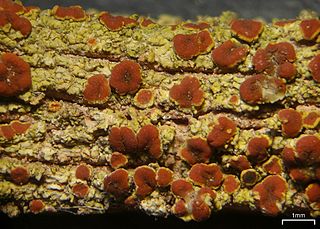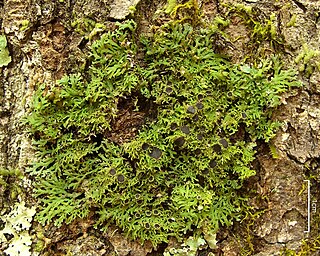Description
The Physiaceae family includes various growth forms such as foliose, fruticose, squamulose , stipitate, crustose, and even evanescent types (where certain parts, such as basal squamules, become less noticeable or disappear over time as other structures develop). Some members of this family may also be lichenicolous, meaning they grow on other lichens. These lichens can exhibit features such as lobules , isidia, and soredia, or may lack them entirely. [2]
The upper cortex of Physiaceae lichens can be prosoplectenchymatous , paraplectenchymatous , or absent. Their photobiont, or the symbiotic algae living within the lichen, is typically a unicellular green alga from the genus Trebouxia , with a diameter ranging from 5 to 20 μm. The medulla can vary from poorly to well-developed or may even be absent, and it often contains lichen substances. The lower cortex can be prosoplectenchymatous, paraplectenchymatous, or absent, with the lower surface either possessing or lacking rhizines. A prothallus may be present or absent. [2]
Physiaceae lichens produce ascomata, which can be either apothecia or mazaedia . Their apothecia can be immersed, sessile, or short-stalked, with a more or less distinct exciple. The disc , when present, is generally round and ranges from flat to convex, displaying colours from brown to dark reddish-brown or black. A thalline exciple may or may not be present, while the proper exciple can be thin and weakly pigmented or well-developed and darkly pigmented. [2]
The epihymenium can be brown-black, brown, or green, while the hymenium is colourless or partly green, with or without oil droplets. The hypothecium can vary in colour from colourless to yellow-brown, brown, or dark brown. paraphyses are simple or sparingly branched in the uppermost part, with thickened apices often capped by a brown-pigmented layer. The asci are clavate , typically with 8 spores (but sometimes as few as 2 or as many as 16) and a well-developed amyloid tholus , a paler conical axial mass, and an ocular chamber. [2]
Ascospores in the Physiaceae family have a single septum, olive to brown in colour, and ellipsoidal in shape, often displaying uneven wall thickenings. The conidiomata are pycnidial , either immersed or superficial. Conidia can be formed acrogenously or pleurogenously, and they can be ellipsoidal, bacilliform , fusiform , or filiform . [2]
This page is based on this
Wikipedia article Text is available under the
CC BY-SA 4.0 license; additional terms may apply.
Images, videos and audio are available under their respective licenses.










